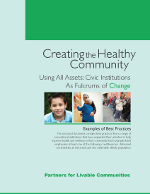
Partners compiled a collection of best practices of traditional community institutions incorporating health and wellness into their agenda and programming to improve community health. The best practices focus on improving the health of at least one of three constituencies: distressed communities, at-risk youth, and the vulnerable elderly.
Examples of institutions include arts and culture organizations, botanical gardens, community development corporations (CDCs), faith-based organizations, libraries, museums, public markets, and zoos.
Click here to download Creating the Healthy Community - Using All Assets: Institutions as Fulcrums of Change
Read more »
Terms:Aging, Community Building, Community Development, Community Engagement, Creating The Healthy Community, Cultural Institutions, Health & Wellness, Healthy Communities, Institutions as Fulcrums of Change , Intergenerational, Libraries, Program Areas, Public Health
On Thursday, the National League of Cities released The 10 Critical Imperatives Facing Cities in 2014, its annual report highlighting ten of the most pressing issues facing cities across the United States. Partners board member and incoming NLC President, Salt Lake City Mayor Ralph Becker explained during the report's unveiling, "This is not a wish list just of cities. This is a wish list of the people who live in America. That’s 80 percent of the population of America that’s being represented through us."
The ten items on the list were:
- Fragile Fiscal Health
- Deteriorating Transportation Infrastructure
- The Shrinking Middle Class
- Inadequate Access to Higher Education
- The Need for Affordable Housing
- A Less-Than-Welcoming Return for Veterans
- Gang Violence
- A Broken Immigration System
- Climate Change and Extreme Weather
- Lack of Public Trust
Click here to read the full report from NLC, which includes an overview of initiatives being taken by cities in their own efforts to tackle these ten challenges and create more livable communities for their residents.
Read more »
Terms:Community Building, Community Development, Downtown Development, Economic Development, Education, Environment, Health & Wellness, Housing, Immigration, Neighborhood Revitalization, Other Reports/Publications, Placemaking, Public-Private Partnerships, Transportation, Urban
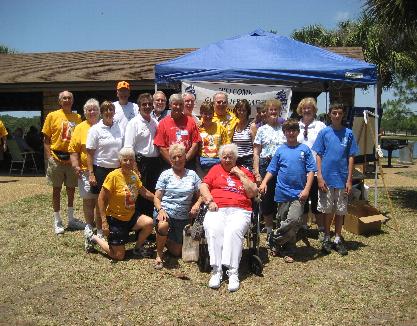
Across America state and local governments are figuring out how to deal with aging populations as modern medicine and technology are starting to ensure that people, on average, live longer. According to the 2012 U.S. Census, Florida possesses one of the oldest populations in the United States, as more than 18% of Florida residents are over the age of 65, almost 5 percentage points higher than the national average. To help their aging population remain healthy and lead productive lives, local governments and community organizations are finding creative ways to encourage active lifestyles for older adults. The Good Life Games of Pinellas County Florida has proven to be a very successful way to encourage fitness among older residents of the county, and their model is being replicated throughout the country.
Read more »
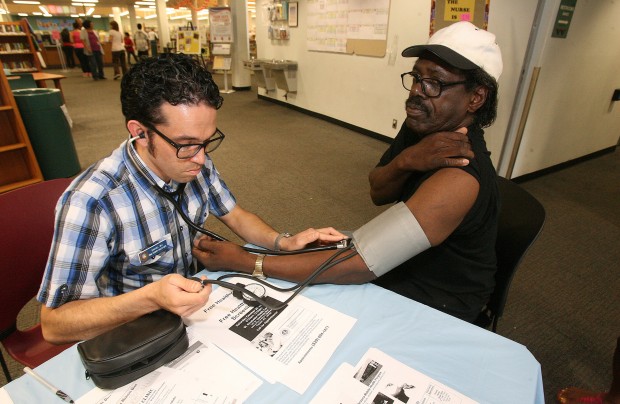
For many counties throughout the United States, the public library system plays an important role in the community, serving as a center for social, cultural, and educational activity. These institutions have become especially important to the homeless and low-income families who may not be able to afford the amenities provided by the library. Pima County, Arizona’s public library system, however, began a program in 2010 that strives to serve another growing need that many communities throughout the country face – access to healthcare.
Read more »
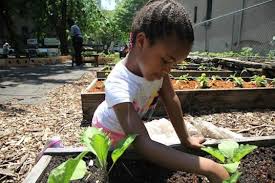
Head Start is a federal program designed to promote school readiness by enhancing the cognitive and emotional development of pre-school aged children. Through a program called “Eat Play Grow,” a series of obesity prevention classes are offered by the Children’s Museum of New York and the National Health Institute to be held in classrooms throughout New York City. Nonprofit groups throughout low-income areas in New York teach classes to children in underserved communities. Classes are held at common neighborhood institutions, such as community centers and libraries.
Read more »
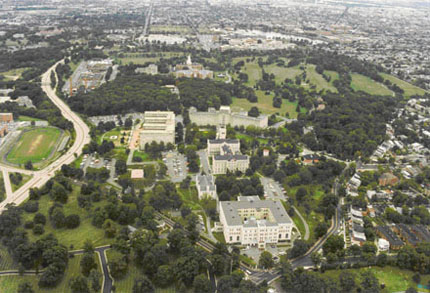
The U.S. Armed Forces Retirement Home in Washington, D.C., commonly referred to as the ‘Soldiers’ Home,’ is one of the country’s oldest veterans’ retirement homes and certainly one of the most beautiful. Located on a 273-acre campus in Northwest D.C., the Home’s green pastures and tranquil lakes sit in stark contrast to the developed neighborhoods of the surrounding community. Since the home opened in 1851, the retirement community has been home to thousands of retired elderly and disabled veterans in the Washington area.
Read more »
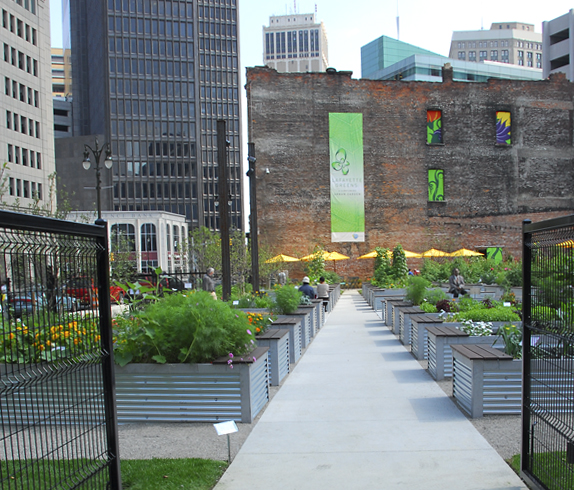
In 1923, when the Lafayette Building was constructed in downtown Detroit, the city was one of the cultural centers of the United States and home to an exploding automotive industry. Famous American architect C. Howard Crane designed the cutting edge, Italian Renaissance-style building in a unique ‘V’ shape to maximize the amount of natural light allowed in. Today, however, Detroit has fallen on harder economic times, and the once striking skyscraper at 144 West Lafayette was torn down in 2010 after being vacant for more than a decade.
Read more »
Terms:Community Building, Cultural Institutions, Downtown Development, Environment, Health & Wellness, Historic Preservation, IFC Best Practice, Neighborhood Revitalization, Parks, Playgrounds & Gardens, Urban
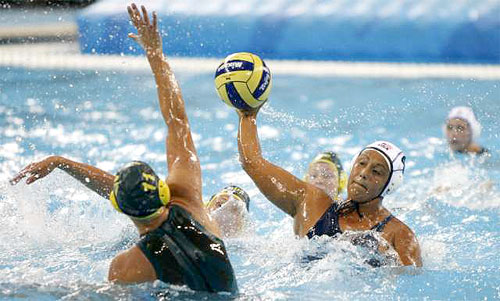
When kids from Commerce, a small working-class city outside of Los Angeles, are asked who their heroes are, they will, more often than not, mention local residents Brenda Villa and Patty Cardenas. Villa and Cardenas were both key members of the Women’s Olympic Water Polo Team from the 2008 Olympic Games in Beijing, China, and they are both products of the Commerce Water Polo Club.
Read more »
 The Arlington Energy Masters program is a joint venture between three Washington, DC area nonprofit groups - Arlingtonians for a Clean Environment (ACE), Arlington Thrive, and the Virginia Cooperative Extension (VCE) – which aims to increase energy efficiency in Arlington’s low-income residences. Volunteers from the DC suburb are put through a 20 hour training course on what impacts a home’s water and energy usage and strategies to make homes more efficient. Once the training is completed, volunteers spend at least 60 hours in the community applying their knowledge to help lower energy and water usage in low-income apartments from throughout the county. The Arlington Energy Masters program is a joint venture between three Washington, DC area nonprofit groups - Arlingtonians for a Clean Environment (ACE), Arlington Thrive, and the Virginia Cooperative Extension (VCE) – which aims to increase energy efficiency in Arlington’s low-income residences. Volunteers from the DC suburb are put through a 20 hour training course on what impacts a home’s water and energy usage and strategies to make homes more efficient. Once the training is completed, volunteers spend at least 60 hours in the community applying their knowledge to help lower energy and water usage in low-income apartments from throughout the county.
Read more »
Creating The Healthy Community
Using All Assets: Civic Institutions as Fulcrums of Change
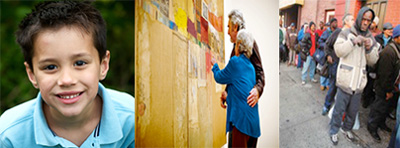
Organizations and government agencies all across the nation are working to improve public health. It’s a huge and complex task, and there is much to be done. Partners for Livable Communities, long recognized for its expertise in mobilizing communities to address social challenges, believes that using a community-based approach to health and wellness can create a more caring, compassionate community and a healthier life for all Americans.
So we’re doing just that. In the Spring of 2014 Partners will kick-off a new agenda: Creating the Healthy Community, Using All Assets: Civic Institutions as Fulcrums of Change (“Fulcrums”). Partners and a network of U.S. cities will address public health issues specific to the community at hand, with a focus on three key demographic groups: at-risk youth, the vulnerable elderly including veterans, and distressed communities. To do so, Partners and its network of Healthy Communities will collaborate with and utilize the resources and expertise of a variety of anchor institutions, ranging from schools to zoos to libraries, museums, community gardens, arts and culture organizations, community development corporations, and beyond.
Members of the Fulcrums network will be considered until February of 2014, so inquire with Program Officer Arianna Koudounas (
This e-mail address is being protected from spambots. You need JavaScript enabled to view it
; 202-887-5990 x106) if you are interested in making your community a Healthy Community.
Read more »
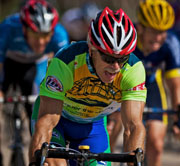 photo credit National Senior Games AssociationThe Good Life Games of Pinellas County encourage adults 50 and over to participate in their own “Senior Olympics,” to promote athleticism and healthy lifestyles. Many older adults are intimidated by the idea of athletic competition, out of fear that an injury or lameness could permanently limit their mobility. Specifically designed to meet the physical capabilities of older adults, the Olympic-style games include archery, track and field, swimming, cycling, and others. Players in Good Life Games are also eligible for statewide and national competitions. photo credit National Senior Games AssociationThe Good Life Games of Pinellas County encourage adults 50 and over to participate in their own “Senior Olympics,” to promote athleticism and healthy lifestyles. Many older adults are intimidated by the idea of athletic competition, out of fear that an injury or lameness could permanently limit their mobility. Specifically designed to meet the physical capabilities of older adults, the Olympic-style games include archery, track and field, swimming, cycling, and others. Players in Good Life Games are also eligible for statewide and national competitions.
Read more »
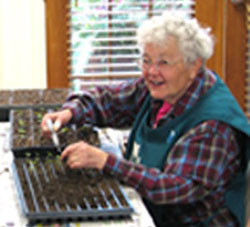 photo credit Cheyenne Botanic Gardens photo credit Cheyenne Botanic Gardens
“The process of working in the Garden has a therapeutic effect: as the plants grow, so does the self-esteem of the older adult volunteers.”—Director, Cheyenne Botanic Gardens
The Cheyenne Botanic Gardens are unique not only for their use of solar and wind energy to enhance sustainability, but also because of their workforce, in which many volunteers are older adults, individuals with disabilities, and at-risk youth. According to Gardens staff, 90 percent of the physical labor is done by volunteers. The Gardens are an invaluable resource to the Cheyenne community, offering all the attractions of a beautiful environment, as well as occasions for structured, meaningful, and healthful activity for members of the community.
Read more »
 photo credit Dances for A Variable Population photo credit Dances for A Variable Population
Dancers dressed in vibrant red move across The High Line, an elevated historic rail line turned public park in Manhattan’s West Side, enticing passersby to stop and look at the beautiful performance. Half of the dancers seem to be young, fit, and professionally trained. The other half move more slowly, some dancing in place, and some sitting. In fact, they are all older adults.
Dance artist Naomi Goldberg Haas founded and directs Dances For A Variable Population (DVP), a dance company whose goal is to erase the borders between dancers and audience through its unique choreography and dance company, comprising adults 24 to 82 years of age. Haas enjoys site-specific dance performances, which place the audience and dancers of all ages in the same space. She says, “[In these] new conceptions of shared space, we celebrate how dance can be a vehicle for wellness and expression for seniors, persons with disabilities, youth, and regular folk; how dance can change from an ‘under-exposed’ art form in a community to become an active tool for community participation, enthusiasm, and social interaction.”
Read more »
 photo credit Deeply Rooted Productions photo credit Deeply Rooted Productions
Founded in 1995 by dancers Kevin Iega Jeff and Gary Abbott, Deeply Rooted Dance Theater teaches and performs dance as creative expression and community and spiritual healing. Jeff calls it “world class art from a grassroots perspective.”
Working within an African American dance aesthetic, Deeply Rooted explores topics as varied as the Somali civil war and famine, the quest to live in the face of AIDS, and early-twentieth-century African American cultures. Jeff and Abbott’s choreography stresses both technical virtuosity and the deep exploration of character and community. As one dancer explains regarding Deeply Rooted’s Life, which deals with personal struggles to live with AIDS, “I know I’m telling experiences of things I see every day. Right outside these doors, there’s some things about this piece that are going on.”
Read more »
Terms:2012, Aging, Aging in Place, AIP Best Practice, Arts & Culture, Chicago, IL, City Leaders Institute on Aging in Place, Cultural Institutions, Health & Wellness, Multicultural
 photo credit LIVENorthern New Jersey’s LIVE (Lifelong Involvement for Vital Elders), an initiative of the Jewish Federation of Greater Metrowest New Jersey (UJC), works with local leaders to make the communities it serves better places in which to grow older. LIVE organizes recreational activities and personal-development programs that help older adults stay active and involved in their communities, thereby helping them to age in place and continue to contribute to their communities well into their older years. The activities offered by LIVE include yoga, Tai Chi, walking clubs, health workshops, and employment counseling. While LIVE is led by United Jewish Communities, it encourages participation from seniors of all ages and backgrounds. photo credit LIVENorthern New Jersey’s LIVE (Lifelong Involvement for Vital Elders), an initiative of the Jewish Federation of Greater Metrowest New Jersey (UJC), works with local leaders to make the communities it serves better places in which to grow older. LIVE organizes recreational activities and personal-development programs that help older adults stay active and involved in their communities, thereby helping them to age in place and continue to contribute to their communities well into their older years. The activities offered by LIVE include yoga, Tai Chi, walking clubs, health workshops, and employment counseling. While LIVE is led by United Jewish Communities, it encourages participation from seniors of all ages and backgrounds.
Read more »
 photo credit Culture Bus photo credit Culture Bus
Culture Bus is at once a transportation service to arts and cultural events for older adults, and a unique treatment program for early-stage dementia patients. One of many adult day programs offered by CJE SeniorLife, in Chicago, Illinois, Culture Bus provides opportunities for socialization, creative expression, and intellectual stimulation designed to improve the quality of life and slow the effects of degenerative conditions such as Alzheimer’s disease for many older adults.
The Culture Bus emerged, in 2002, from an Alzheimer’s support group sponsored by Northwestern University’s Cognitive Neurology and Alzheimer's Disease Center. Its participants were seeking more time together and opportunities for intellectual and social engagement. One member of the group suggested using a bus to enable everyone to go downtown together. The Northwestern staff immediately saw the value in this idea, and reached out to CJE, a local leader in adult-day programming, to discuss a partnership.
Read more »
Terms:2012, Aging, Aging in Place, AIP Best Practice, Arts & Culture, Chicago, IL, City Leaders Institute on Aging in Place, Health & Wellness, Mobility, Social Services, Transportation
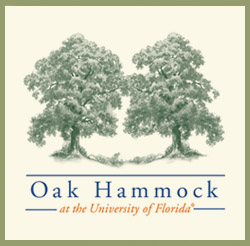 photo credit Oak HammockAs the baby boomers reach retirement age, institutions across the United States will have to find creative solutions to accommodate their burgeoning numbers. Despite this growing need, a retirement community on a college campus might not seem to be a great idea. It’s not difficult to imagine late-night police calls from seniors who think midnight is entirely too late to be playing loud music, or are appalled by the undergraduates who trample the beloved garden of a 90-year old during their late night escapades. But Oak Hammock at the University of Florida, Inc. has created just such an unlikely pairing, a relationship in which university administration, students, senior residents, and other stakeholders have found a lot to like. photo credit Oak HammockAs the baby boomers reach retirement age, institutions across the United States will have to find creative solutions to accommodate their burgeoning numbers. Despite this growing need, a retirement community on a college campus might not seem to be a great idea. It’s not difficult to imagine late-night police calls from seniors who think midnight is entirely too late to be playing loud music, or are appalled by the undergraduates who trample the beloved garden of a 90-year old during their late night escapades. But Oak Hammock at the University of Florida, Inc. has created just such an unlikely pairing, a relationship in which university administration, students, senior residents, and other stakeholders have found a lot to like.
Read more »
Terms:2012, Aging, Aging in Place, AIP Best Practice, Arts & Culture, City Leaders Institute on Aging in Place, Community Engagement, Environment, Florida, Health & Wellness, Housing, Intergenerational, Life-Long Learning, Town-Gown, Youth
 photo credit Project SHINE photo credit Project SHINE
“When I first came to America, I only knew a couple letters. I couldn't communicate with anybody. And I learned about this program and I started (to learn English). I have been here for three years and now I have built a basic vocabulary that I can carry my daily life. It basically helped me to live in America." -Project SHINE participant
In the early 1980s, Nancy Henkin, founder and director of the Intergenerational Center at Temple University, was shocked by the news that loneliness and social isolation led an elderly Asian woman to commit suicide, at a time when it was commonly assumed that older immigrants were part of tight-knit and supportive communities. Henkin realized that older immigrants often struggle with language barriers, changes in customs, and differences in social roles more than their younger counterparts, and began working to establish a program that could support them. Project SHINE was launched in 1985, to reach out and provide aging immigrants with language and cultural resources to help them adapt in their new community.
Read more »
Terms:2012, Aging, Aging in Place, AIP Best Practice, City Leaders Institute on Aging in Place, Community Development, Community Engagement, Education, Faith Community, Families, Health & Wellness, Heritage, Immigration, Intergenerational, Jobs, Life-Long Learning, Multicultural, National, Youth
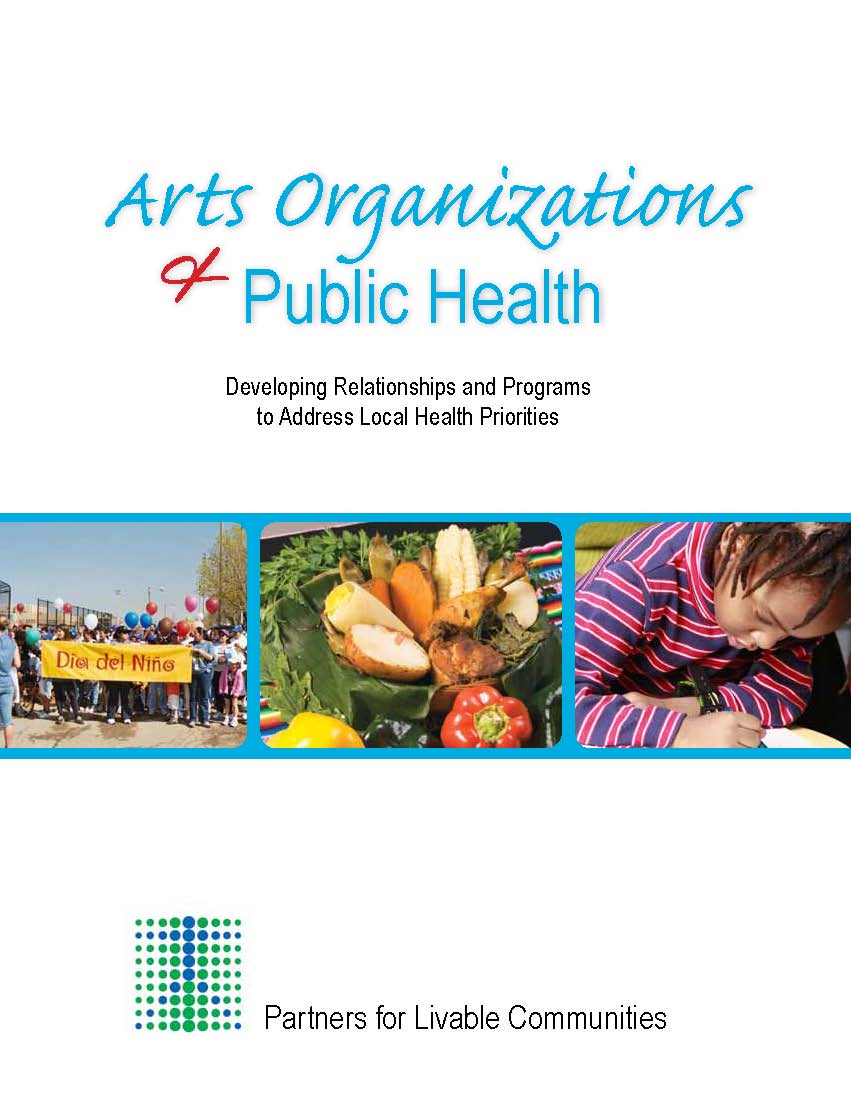
Partners for Livable Communities (Partners) releases Arts Organizations and Public Health, a guide to creating partnerships between art and health organizations. This primer was designed for the arts organization that wishes to initiate programming focused on local health issues, or create partnerships with health groups in order to best meet the needs of the community. Arts Organizations and Public Health identifies best practices of diverse arts organizations from around the United States to inform this work. The best practices can be used as references, and are cited throughout the publication to correlate with text.
Read more »
Age Friendly Cities
Rapidly urbanizing world populations are also rapidly aging. The number of people aged over 60 worldwide is expected to double from 11 percent to 22 percent by 2050 [i]. The need to adapt cities to meet the needs of an aging population is more important now than ever, and creating connected cities accessible for all ages is an integral part of responding to these demographic shifts. The World Health Organization (WHO) has been at the forefront of fostering responsible policymaking and networking related to aging in cities, and organized its Age Friendly Cities Project [ii] in 2005.
Read more »
|
|